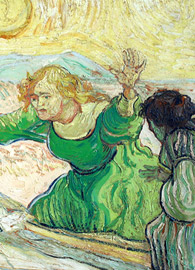John Week 6
Death, Mission and Discipleship: It’s All in the Details: John 11:1–12:50
Seattle Pacific University Assistant Professor of New Testament
Read this week’s Scripture: John 11:1–12:50
16:11
Key Prologue Words: life, rejection, belief, revelation
The Small Stuff Matters
The writer Anton Chekhov articulated a principle of storytelling that essentially claims that all details matter. He said (in various forms), “If in the first act you have hung a pistol on the wall, then in the following one it should be fired. Otherwise don’t put it there.” [Author’s Note 1] In other words, a well told story only contains essential pieces. Readers then know to pay attention to details, as they will matter later in the narrative. [Author’s Note 2] There are no extraneous words.
While John’s gospel does not subscribe to this method of storytelling wholeheartedly, there are certain chapters, like John 11–12, that slow down on the action and linger on the details in order to foreshadow events in Jesus’ life.
Looking Ahead

 Enlarge
Enlarge
John 11–12 narrates the final two chapters of Jesus’ public ministry. Readers with good memories of Matthew, Mark, and Luke may be surprised that we are only halfway through John’s gospel and yet we are already at the beginning of passion week. Passion week is the week beginning on Palm Sunday (Jesus’ entry into Jerusalem, John 12:12–19), including Jesus’ crucifixion (John 19), and ending with Jesus’ resurrection (John 20:1–18).
John’s gospel concludes the narrative of Jesus’ conflict with the religious authorities in this section, but it actually just puts this conflict on pause. The gospel resumes this story and brings it to a climax at Jesus’ trial in John 18. In this way the gospel can focus on Jesus’ last words, acts, and prayer for his disciples, preparing them for his absence and the arrival of the Spirit (John 13–17). By raising Lazarus from the dead, Jesus foreshadows the way he will conquer death by dying. This action brings about the final rejection from the authorities. Jesus also shows us how his mission redefines the terms messiah, king, and savior. Lastly, the gospel illustrates what discipleship looks like in these chapters.
Conquering Death
When we begin John 11, Jesus and his disciples are in a village across the Jordan River (confusingly called Bethany; cf. 1:28). They have left Judea to escape from arrest (10:39–40). When the story begins they encounter a messenger from another city named Bethany, located very close to Jerusalem, where friends of Jesus live (11:1–3). Jesus does not leave when he hears that one of his friends named Lazarus is sick. Lazarus is even described as “he whom [Jesus] love[s]” (11:3). Jesus’ statement that the illness “does not lead to death” seems both true and ironic in light of the whole story (11:4).
Essentially the introduction to this story asks John’s audience to see this last sign of the gospel as yet another way in which Jesus points to God’s glory (meaning God’s presence) by showing how the miracle relates to his death and resurrection. This sign may in fact be one of the clearest in the gospel, which is why it is prominently located before the gospel’s final chapters (John 13–21).
When Jesus claims that Lazarus’ illness will glorify God and God’s Son, Jesus is not saying that all illness, any more than all blindness or other physical infirmities (9:2–4; 11:4), leads to God’s revelation or glory. Rather, these two healings (note: “this sickness,” 11:4), the healing of the blind man (see Lectio 5) and the resurrection of Lazarus, point to God by revealing God’s presence in the new age. This presence is brought about by Jesus’ incarnation, death, and resurrection. [Author’s Note 3]
In fact, Jesus is clear that Lazarus’ death is an event that demonstrates how he is conquering death. Here death is not seen as the inevitable consequence of life or as something only to mourn. Martha and Mary seem to deal with death this traditional way. They believe, along with other Jews in the first century, that God will raise the bodies of the dead, but that this resurrection will happen at the end of the age (see John 5:28–29; cf. 2 Maccabees 7:1–42; Daniel 12:2).
Jesus seeks to show Martha how the expectation of this future resurrection is currently available in his presence. By saying, “I am the resurrection and the life,” (John 11:25) Jesus indicates that part of his mission to come and offer abundant life (10:10) is in fact to conquer death. Even though people still die, they will live, as Lazarus will demonstrate (11:23). And those who live and believe in Jesus will “never die” in the sense that their abundant life continues with him, as death doesn’t have a hold on him (11:26).
Through his interactions with Mary, Jesus continues to show that he has come to conquer death. When Mary and the Jews with her weep in mourning, Jesus is “greatly disturbed in spirit and deeply moved” (11:33), and he weeps with them (11:35). Jesus’ tears are not the same kind of tears of loss that Mary’s likely are, however. Instead, the word used to describe Jesus’ disturbed spirit (ἐμβριμάομαι, embrimaomai) is often used in a context where it means “scolding” or “rebuking,” with an element of anger (cf. Daniel 11:30; Matthew 9:30; Mark 1:43; 14:5). Here Jesus’ anger is not directed at himself, reproaching himself for not coming sooner (11:6). We know that Jesus came precisely when he chose to arrive. Nor is his anger directed at Mary; he weeps too. Instead his anger is directed toward death itself. Jesus has come to bring abundant life. Therefore, he is opposed to death and all that it entails.
Finally, Jesus’ successful resurrection of Lazarus is described in terms that parallel Jesus’ own resurrection. Note the similarities. Jesus commands that the stone be removed from the cave (11:38–39; 20:1). One that Jesus loves is there (11:36; 20:2). A woman named Mary is weeping (11:33; 20:11). The resurrection gives glory to God (11:40–42; 20:17), the Author of life itself. Yet there is one stark contrast: when Lazarus is raised, he comes out of the tomb with the grave clothes still binding him (11:44). It is as though death still has a hold on Lazarus; indeed, Lazarus will die again. However, when Jesus rises from the dead, he leaves the grave clothes behind (20:5–7). Death no longer has any claim on him, and through him those who believe in him are likewise freed from death’s grasp. Like Lazarus, they will die again. But like Jesus, they will live.
Coming Death

 Enlarge
Enlarge
The opening passage of John 11 indicates that Jesus is staying away from Judea because people there want to arrest him, but it is not his time yet (10:39). This has been a repeated statement for a few chapters; indeed, his hour (of trial, death, resurrection, and exaltation) is almost here (12:23). The disciples are aware that returning to Judea puts Jesus, and therefore themselves, at risk (11:7–8, 16). While the disciples may be declaring their willingness to die without the confidence to back it up (e.g., 18:15–18, 25–27), [Author’s Note 4] they do recognize that Jesus’ actions in returning to Judea and acting on behalf of his friend will endanger him (and potentially themselves).
As the previous section indicates, we are to read this story about the raising of Lazarus in light of Jesus’ own death, which conquers death and brings resurrection. However, we are also to read it in light of its placement in the gospel: this is the event that triggers the crystallization of the plot to kill Jesus (11:45–53). While the gospel has narrated that the authorities “were seeking” to kill Jesus since John 5:18, now they are making formal plans to do so (11:53). These plans will bear fruit in a relatively short amount of time.
Rejection
Immediately after Jesus raises Lazarus from the dead, John states that many who witnessed the event believed in Jesus (11:45; cf. 2:11). Interestingly, others went and told the Pharisees what Jesus had done. This division in the crowd is a common theme in John. Jesus’ actions force people to make a decision about him.
The Pharisees and chief priests come together to call a meeting of the council in direct response to Jesus’ actions in raising Lazarus. Amazingly, the Pharisees and chief priests are not astonished by Lazarus’ incredible resurrection. They are not scared of someone who raises people from the dead. Instead, they are scared by the effects on the crowd. Too many people believe in Jesus (11:47). They have reached a tipping point, and they are worried that “everyone will believe in him, and the Romans will come and destroy both our holy place and our nation” (11:48). [Author’s Note 5]
Mission
As the council indicates (11:47–53), confessing Jesus to be the Messiah brings with it a host of political ramifications. The officials of the Roman Empire were not in favor of Jewish messiahs, as messiahs tended to be political revolutionaries who desired Israel’s independence from Rome. The original associations with the word messiah, meaning “anointed one,” were God’s first anointed ones, the kings, who were in charge of ruling Israel. Simply put, Caesar Augustus would not have favored a claimant to Israel’s throne.
The triumphal entry into Jerusalem (12:12–19) in some ways does not help counter these ideas. Jesus is heralded as a victorious king by a crowd waving palm branches who calls him the “King of Israel!” (12:13). However, in a slight shift from the other gospels, John has this cry from the crowd precede Jesus finding and riding a young donkey (12:14). In this way Jesus is reinterpreting the crowd’s cry. The king who rides in on a donkey is not the triumphant, victorious warrior. Instead, he is a humble king (Zechariah 9:9). John is candid: it takes until after the resurrection for the disciples to understand the difference, so it is no surprise that the crowd is not able to understand it yet (John 12:16). Jesus’ distinctive teaching on the kind of king he is will be a theme throughout the passion narrative.
In these chapters, however, Jesus is not only heralded as Messiah and King. He is also the Son of Man who is to die and be raised, as Jesus predicts for a third time (12:32). In dying and rising, he will “draw all people to” himself (12:32). Furthermore, immediately after the crowd heralds Jesus as a king when he enters Jerusalem, the Pharisees are terrified because they think “the world has gone after” Jesus (12:19). This is proven to be true in some ways, as “some Greeks” inquire about Jesus, demonstrating that Jesus is influencing and saving people who are not part of the nation of Israel. [Author’s Note 6]
Discipleship
John 11–12 serves as a prelude to Jesus’ instruction to his disciples before his death (John 13–17) in one additional way. At this point in the gospel, Jesus engages in further and more specific teachings on discipleship. The gospel presents these teachings not in the form of stated discourses, but rather in the form of models. Lazarus, Martha, Mary, and Jesus himself all embody particular aspects of what it means to be a disciple.
Lazarus is described as Jesus’ friend (11:11) as well as one whom Jesus loves (11:3, 5, 36). As we will see in John 13–21, this places Lazarus in a very similar position as the “beloved disciple” whom we have yet to meet (cf. 13:23). [Author’s Note 7] In this way Lazarus is a model disciple, not because of what he does (other than coming out of the grave, very little is recorded about him), but rather because of Jesus’ love for him. [Author’s Note 8]
Martha is also portrayed as a model disciple in the Gospel of John, in that she can complain to Jesus, show confidence in him, and demonstrate a full confession of faith, all in one encounter on the road (11:20–27). While Martha has trouble understanding how the resurrection (expected in the last days of the age) could somehow refer to Jesus now, she is able to articulate a confession of faith that includes several important titles: Messiah, Son of God, and “the one coming into the world” (11:27). These titles point forward to Jesus’ death (especially Messiah), and they also point backward to Jesus’ origins with God (1:1–18). In this way Martha has summarized the good news of the gospel because she knows who Jesus is, from beginning to end.
Mary epitomizes what it means to be Jesus’ disciple in several ways. While Lazarus is portrayed as an ideal disciple because of the way Jesus relates to him, and Martha is an ideal disciple because of what she says, Mary is an ideal disciple because of what she does in obedience to Jesus. First, demonstrating that she is like the sheep that knows the shepherd’s voice, she comes to Jesus when he calls her (11:28–29; cf. 10:3–5). [Author’s Note 9] Second, when she washes Jesus’ feet (12:1–8; cf. 11:2) she is foreshadowing the very action that Jesus will command his disciples to do (13:13–15). [Author’s Note 10] In fact, she will obey this commandment to wash feet in an extravagant manner. Mary’s actions of service demonstrate that she is a model disciple.
Finally, Jesus indicates later in the gospel that the consummate act of love is to lay one’s life down for one’s friends (15:13). Jesus has begun to do this for specific friends, as he knowingly risks his own life to bring life to Lazarus, and to Mary and Martha. He willingly faces death, unlike Caiaphas and others, in order to conquer the “ruler of this world,” Satan (12:31), and to restore the world to God’s abundant life. Jesus leaves the crowds with a decision to make: they can follow the light, or oppose it and remain in darkness. This light does not guarantee that they have all the answers, as Mary, Martha, and Lazarus indicate. Even so, it does promise the way of love, faith, obedience, and abundance for those who pay attention to the details.
Questions for Further Reflection
- Based on what you’ve seen in John, how would you say that Jesus conquers death through dying?
- In what ways have the terms messiah, king, and savior been redefined in these chapters of John?
- The Pharisees and the chief priests do not find anything astonishing about Lazarus’ resurrection except the political danger. Obviously they do not deny that the resurrection has taken place because they are taking steps as a direct result of it. How do you account for their actions?
- John 11–12 illustrates four models of discipleship. Which model is most like you now? Which one would you most like to be?
<<Previous Lectio Back to John Next Lectio>>




